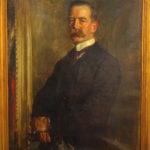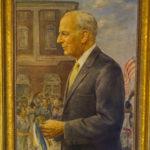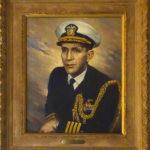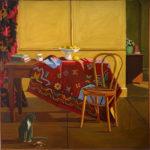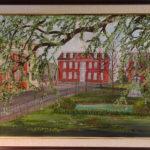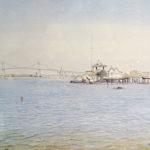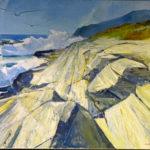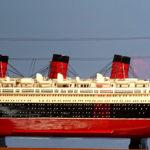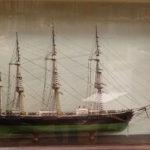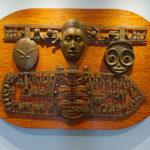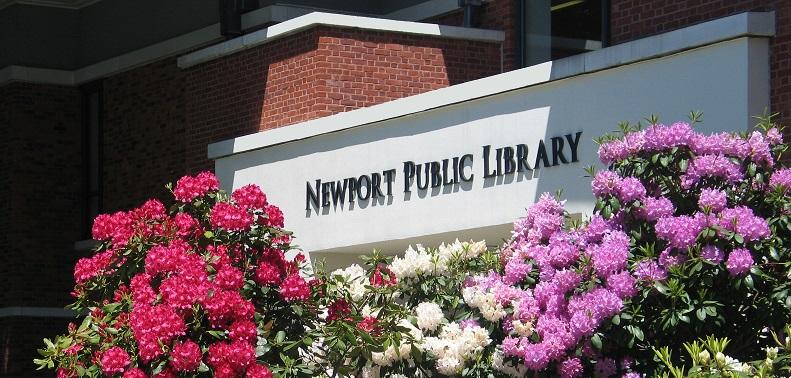
The inception of a public library in Newport began in the summer of 1865 at the behest of Sophia Louisa Little (Robbins) 1799-1892, a local poet, and Daniel Parish Jr., a summer resident from New York.
Figure 1. Sophia Little, From Portraits of American Abolitionists, Photo. Coll. 81, Massachusetts Historical Society Photo Archives. Photo 81.415, accessed March 15, 2021. https://www.masshist.org/database/1264. Animated with AI.
Privately incorporated public libraries for the working class gave those who could not afford membership at private libraries, like the Redwood Library and Athenæum, the opportunity to freely access a wealth of print materials.
The Newport Free Library and Reading Room was established in the summer of 1865 by Little and Parish above the plumbery Joseph M. Lyon located at 236 Thames Street at the corner of Gidley Street. Over the winter, Parish returned to New York while Little managed the Room. Her library was the first public library established in Rhode Island. It was contemporaneous to subscription libraries such as the Redwood Library, the Mechanic and Manufacturer’s Association Library, and the Young Men’s Christian Association Library. However, these libraries required a fee or membership to utilize their services.
The YMCA established a fund for their library in October 1864.2 In charge of the library committee were Henry H. Fay, Reverend Charles H. Malcom of Second Baptist Church, Reverend Dr. Thatcher Thayer. In March of 1865 the Ladies’ Fair was held at Fillmore Hall they sold baked goods and preformed tableaux vivants for the crowd. The U. S. Band from Fort Adams played to much fanfare. They raised nearly $600, a princely sum which allowed the YMCA to continue to purchase books for their library.3 In November the library was housed at the rooms of Ernest Goffe, a cabinet maker on Washington Square.
The success of the YMCA library was noticed by the nascent public library. In 1866, David Fales, a lawyer and author of the Library’s Act of Incorporation, joined the YMCA and convinced their president Henry Fay to loan their books, shelves and table to the Newport Free Library and Reading Room.4
The additional books created a need for larger rooms. The Library would move in 1867 to larger quarters at 74 Thames Street. According to the atlas for the city, the original numbering of Thames street places this three buildings down from the intersection of Touro Street. The library occupied the second floor of a clothier shop run by Francis Lawton, the building was later owned by William Cozzens.
The library relied primarily on donations to increase the number of books on its shelves. As the library grew it became necessary to formalize the corporation, so on Sophia Little’s behalf, eleven men submitted a request to the General Assembly of Rhode Island in January of 1867 to incorporate the Newport Free Library and Reading room.6 Little’s desire to establish a free library for working people in Newport was driven by an ideal that the library still embodies: all for free, all for you.
The Board of Trustees consisted of thirteen members. Thomas Wentworth Higginson was President. He is noted for service in the Civil War, hi letters with Emily Dickinson, and an author in his own right. Daniel Parish Jr. was Vice-President, and corresponded from New York City to the other trustees. Charles E. Hammett Jr. was the secretary and was a prominent member of many organizations in Newport. David Fales remained involved as Treasurer. Many noteworthy citizens were corporators, including Henry H. Fay formerly president of the YMCA.7
Following in the footsteps of the YMCA the library held a free concert in March of 1868 with the Mendelssohn Quintette Club of Boston preforming. It quickly became clear according to the Director’s report for 1867-1868 that “the accommodations of the Library are entirely outgrown; there is not shelf room for books, nor space for additional books.”7 The collection of the library consisted of 3,000 volumes.
Christopher Townsend, a native of the city, took interest in the library. Townsend had made his fortune with Edward King (1815-1875) in China through the aegis of Russell and Company between 1835-1844. The trade consisted of Turkish opium for silver specie, silver for silk and tea, then the dry goods were sold by Townsend in New York City.8
The most pressing issue was finding larger accommodations to provide room for the growing collections of the Newport Free Library. Townsend purchased the Rhode Island Union Bank Building at 178 Thames Street, and the Newport Land Evidences illustrate his intent to give the building entirely to the Newport Free Library.
However, due to the constraints in their 1867 Act of Incorporation regarding the amount of real and personal estate, it became expedient to incorporate a new organization with a limit set $70,000 higher than the Newport Free Library’s $30,000. Thus, in January of 1869, the Rhode Island General Assembly recorded that Christopher Townsend conveyed the purchase of real estate on 27 May 1868 by Oliver Reed, William P. Sheffield, and John T. Bush so that they might establish a free library in Newport.10 When the Act was read by the General Assembly on 19 February 1869 it passed in concurrence and established those individuals as the Trustees of the People’s Library.
His book selection, largely carried out in the bookstores of London, numbered some 7,000 volumes. These books along with those collected by the efforts of Sophia Little curated a collection numbering 10,000 volumes for Newportians.
The People’s Free Library opened their doors on 4 May 1870 with the combined collections of the Newport Free Library, Townsend’s curated collection, and the services of the Newport Free Library’s Librarian Elma M. Dame, as the People’s Free Library. The Library was dedicated in a public ceremony before the Mayor, the City Council of Newport and the Trustees of both libraries. Regarding the gift of the library by its benefactor, Mayor Atkinson is quoted in the 5 May afternoon edition of the Newport Daily News as saying
…the usefulness of this benefaction will be gratefully appreciated by every intelligent person in this community, and especially by that portion of our inhabitants, whose limited means necessarily restrict them from having access to Libraries more exclusive, it would be doing them the grossest injustice to doubt for a single moment. Its intrinsic value is exhibited in every alcove, and upon every shelf throughout these well-arranged and beautiful apartments.11
The Institution thrived, and by the time of Mr. Townsend’s death in 1881 the collection had grown to 25,000 volumes.12 The People’s Library remained at 260 Thames from 1870 until 1914, when the collection, by then numbering some 30,000 volumes, was removed to new quarters in Aquidneck Park.13
In order to house the Library more adequately, Mr. George Gordon King, son of Edward King, offered his family home to the people of Newport as a Christmas gift in the winter of 1912. The initial concerns of moving the library away from the center of town was weighed against the considerable danger of fire that being centrally located presented.14
The bequest was gratefully accepted by the City and the people of Newport, as well as the Trustees of the People’s Library on 21 January 1913.15 and in 1914 the Library’s collection of 30,000 volumes was moved to the King home. The building had been modified to make it more suitable for use as a Library. As part of this process that part of the house which had been used as a kitchen and pantry was converted to a large closed stacks area.
In August of 1914, in response to moving away from the middle of the city, and to provide greater access to its residents, a reading room was opened in the Callender school. While it was under discussion in 1914, the reading room in Coggeshall School was not opened until 5 January 1917.
In order to provide more access to the library, two deposit station were placed in the city one on 45 Thames St in the Whitford Pharmacy opened 3 November 1919 and the other on 30 March 1920 in the Jewelry shop of Mr. L. N. Vaughan at 104 Broadway. The two deposit stations were then consolidated in 1921 at Clarkson’s Studio on 167 Thames Street.
A branch Library was opened on 15 May 1926 located at the intersection of Washington Square and Duke Street. The Librarian’s report reads: “There is a fiction room and a children’s and charging room. We have a number of current magazines and newspapers there, as well as large deposits of both fiction and non-fiction. Here again it is interesting to note that with a collection of books not exceeding 5000, the circulation averaged about two-fifths of the entire yearly circulation last year. This can only be attributed to the central location of the Branch Library.” The Branch library would remain open for sixteen years, closing on 9 July 1942.
The history of our Library was best said by a past director, Anne Toll,
But these changes have been only the latest in the long history of the library… From its inception in 1867 to the present; through changes in location from Thames Street to the King House and the branch library on Washington Square to its present location; through name changes from the Newport Free Library and Reading Room to the People’s Library to Newport Public Library; through changes in method for circulation and cataloging; through changes in personnel over the years; the purpose of the library has remained steadfastly the same—to provide the best library services possible with the resources and staff available.16
Footnotes
- Portraits of American Abolitionists, Photo. Coll. 81 Massachusetts Historical Society Photo Archives. Photo 81.415, accessed March 15 2021. https://www.masshist.org/database/1264.
- Young Men’s Christian Association of Newport, Meeting Minutes, 18.
- Newport Daily News, 18 March 1865.
- Letter dated 19 November 1866. New-York Historical Society.
- Boyd’s Newport City Directory, 1869-1870, 178
- Hopkins, G.M. Atlas of Newport Rhode Island. 1876, 26.
- General Assembly of Rhode Island. An Act To Incorporate The Newport Free Library And Reading Room In Newport, January 1867. 201. (Plate 1)
- Librarian Report for the Newport Free Library, 1867-1868.
- Edward King, Ethel Russell King, ed., Journal and Letters of Edward King, (New York: 1934), 94.
- City of Newport, Land Evidences, 1867-1869, vol. 40, 537. Microfilm.
- General Assembly of Rhode Island. An Act to Incorporate the Trustees of the People’s Library in Newport. January 1869. 203.
- Newport Daily News, “The People’s Library” 5 May 1870.
- Bayles, Richard M., History of Newport County Rhode Island. From the Year 1683 to the Year 1887. (N.Y., L. E. Preston & Co.: 1888), 508.
- The numbering of buildings on Thames street seems to have changed in sometime between 1882-1884, formerly 178 Thames Street, the Library’s new address remained 260 Thames Street for forty-four years.
- The People’s Library December 6 1901—December 22 1913 Scrapbook Volume 1, Letter dated 26 December 1912.
- The People’s Library December 6 1901—December 22 1913 Scrapbook Volume 1, Letter Dated 21 January 1913.
- Anne B. Toll, Annual Report of the Librarian 1982-1983 (Newport: Newport Public Library, 1983), ii.
